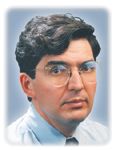Article
30-minute TUMT unit is promising for BPH relief
Dallas--Interim data from a long-term study under way at five U.S. centers offer hope of enhanced relief for men with BPH.

The 3-year study was designed to test the efficacy of the new-generation cooled transurethral microwave thermotherapy Cooled ThermoCath (CTC) system (Urologix, Minneapolis) against high-temperature treatment with Urologix' Targis system. Seventy men with a median age of 67.2±8.3 years who had exhibited symptoms of BPH for an average of 6.9±4.2 years and whose pretreatment median prostate size was 49.4±21.5 grams underwent a single outpatient treatment with the CTC system.
Only oral and topical analgesics were administered during treatment. Enrollment criteria included an AUA Symptom Score (AUA-SS) ≥8 and peak urinary flow (Qmax) ≤ 15 mL/second.

According to Dr. Roehrborn, MRI studies showed that the area of necrosis induced is comparable between the old and new styles of transurethral microwave thermotherapy units.
"The shorter-duration catheter of the CTC is as effective as the old style, but it is better tolerated, no doubt about it," he said. "When you ask the patients, they say they would do it again or would recommend it. Pain scores [during treatment] were very low-2.9, compared with 4.5 with the old style catheter-and that's the main point."
Following treatment, 47.6% of patients in the CTC group did not require catheterization, almost 40% required intermittent self-catheterization, and 12.7% (1 patient for <1 week) required an indwelling catheter. No serious adverse events were reported, and the number and severity of adverse events were comparable for the old and new treatments.
Statistically significant results
At 6 months after the single CTC treatment, AUA-SS improved by 61% from baseline (8.0 vs. 20.4); Qmax improved by 63% over baseline (13.4 vs. 8.2 mL/sec); quality of life score (QoL), improved by 59% (1.6 vs. 3.9) and bother score rose by 66% (5.1 vs. 15.2).
At 12 months' follow-up, statistically significant improvement essentially was maintained across all parameters (p<.0001) in the CTC group. Follow-up at 24 months showed QoL scores with the CTC unit improved by 50% from baseline.
Five of 66 patients in the CTC group (4% to 5% per year) required re-treatment by 2 years post-treatment, but according to Dr. Roehrborn, that rate is common for minimally invasive treatments for BPH.
"It's the price you pay for lesser efficacy compared to tissue-ablative surgeries requiring general or spinal anesthesia," he observed.
Was Dr. Roehrborn surprised at the interim results of the study?
"Not at all," he responded, but added that the improved comfort patients experienced during CTC treatment was an important consideration for physicians considering TUMT for their patients with BPH.
Dr. Roehrborn is a scientific study investigator for Urologix.





